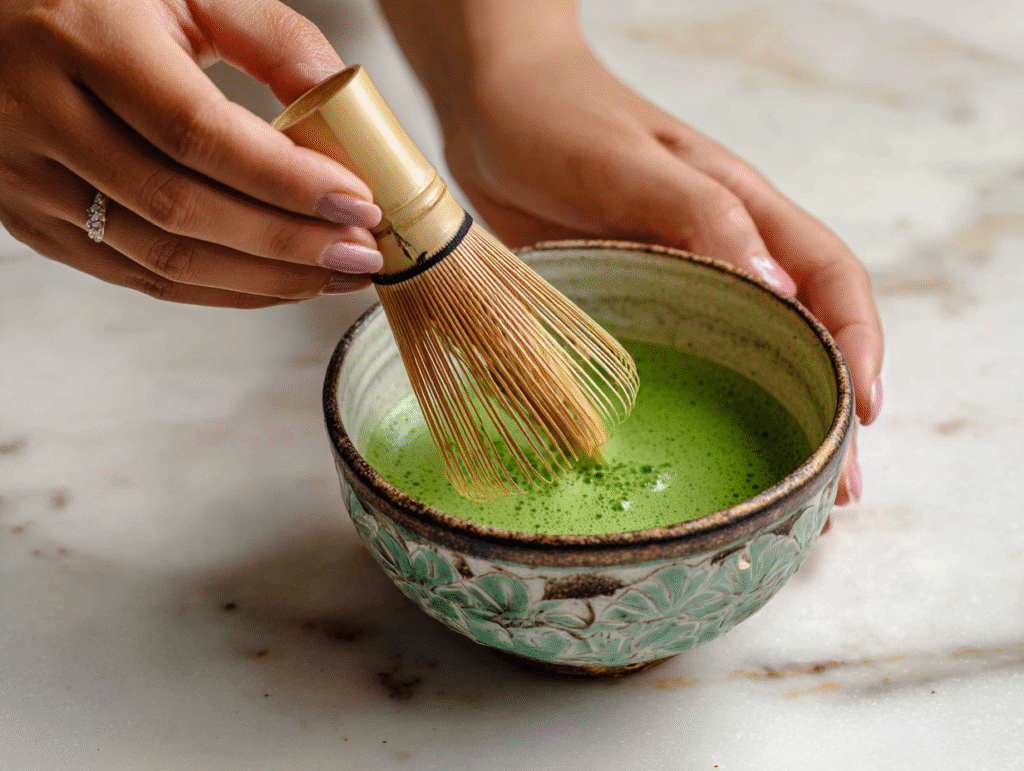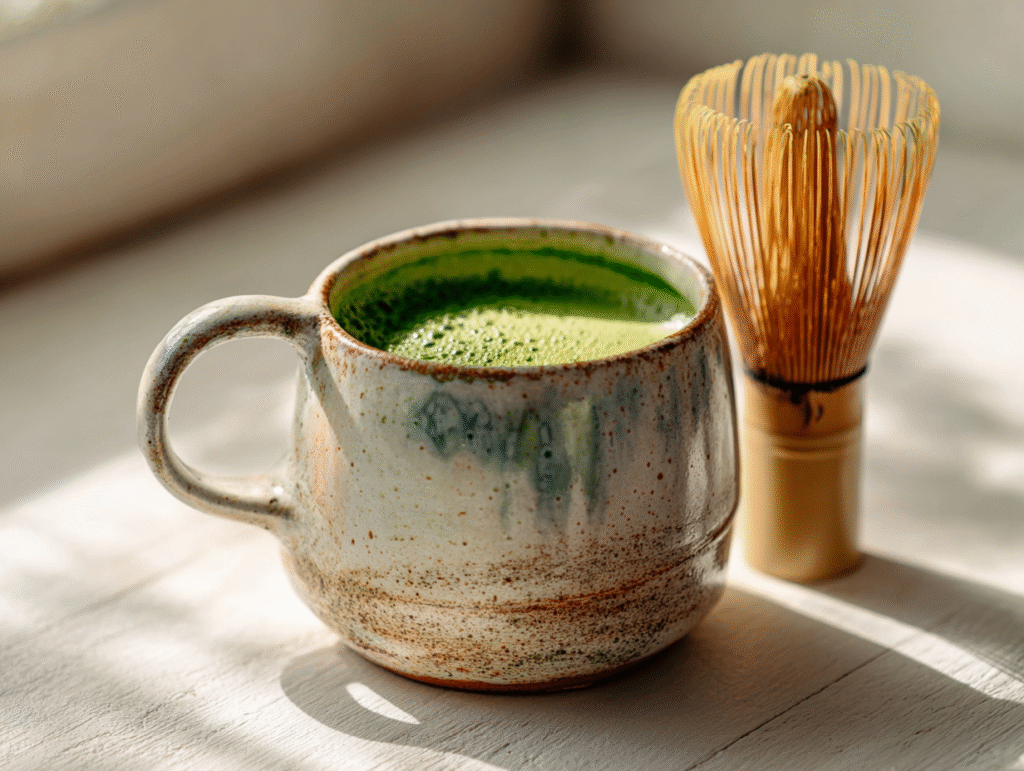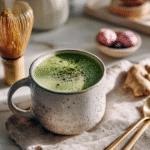In the world of natural wellness, the “Japanese Mounjaro” drink is gaining attention as a gentle, functional alternative to synthetic weight loss solutions. Inspired by traditional Japanese ingredients like matcha, kombu, and umeboshi, this warm tonic blends centuries-old wisdom with today’s interest in detox and gut support. While it’s not a miracle cure, it’s a nourishing, metabolism-friendly drink you can make in minutes at home. In this article, we’ll explore the meaning behind the Japanese Mounjaro drink, why it works, and how to make it part of your daily wellness routine.
Japanese Mounjaro & My Mountain Roots
What Is the Japanese Mounjaro Drink?
The Japanese Mounjaro recipe is a warm, mineral-rich tonic designed to support metabolism, digestion, and energy. While the name borrows from the weight loss drug “Mounjaro,” the drink itself is rooted in traditional Japanese wellness practices—not pharmaceuticals. It typically includes four main ingredients: matcha powder, kombu (edible kelp), umeboshi plum, and fresh ginger. Sometimes a splash of lemon or honey is added for flavor.
Unlike the viral “natural Mounjaro” drink that includes lemon, ginger, honey, and apple cider vinegar, the Japanese version offers a deeper cultural connection. Kombu infuses the water with iodine and minerals, matcha delivers antioxidants, and umeboshi—a fermented plum—provides natural probiotics and acidity to support gut health. Together, these ingredients create a low-calorie drink that hydrates, satisfies, and gently energizes without relying on sugar or caffeine highs. It’s a warm hug in a cup—exactly the kind of comfort we champion in our healthy recipes.
A Kitchen Memory from My Mountain Home
The first time I stumbled on an umeboshi plum, I was standing in the aisle of a tiny health store in Asheville, wrapped in the scent of herbs and dried seaweed. I didn’t grow up with kombu or matcha. But I did grow up with something just as powerful: the belief that food can restore you.
My grandmother’s kitchen was always full of homemade teas and healing broths. When someone had an upset stomach, we didn’t reach for pills—we reached for warm drinks. So when I read about the Japanese Mounjaro recipe online, it struck a chord. It reminded me of the simple tonics we’d make back home, using what we had and trusting nature to do its work.
Now, as a mom and a home cook, I love recipes that feel both nourishing and easy. The Japanese Mounjaro drink is exactly that. I often pair it with a light morning snack from our drinks or comfort categories—it’s grounding, flavorful, and a beautiful start to the day.
Nutrient-Packed Ingredients & Their Benefits
The Real Power Behind Kombu, Matcha & Umeboshi
Each ingredient in the Japanese Mounjaro recipe has a long history in Japanese cuisine—and a powerful purpose.
Kombu, a mineral-rich sea vegetable, is one of the foundations of dashi (a traditional broth). When steeped in warm water, it releases glutamic acid (natural umami), iodine, and trace minerals that help support thyroid function and digestion. Its flavor is mild but grounding, making it an ideal base for this detox drink.
Matcha, a powdered form of whole green tea leaves, contains antioxidants called catechins, especially EGCG, which supports fat oxidation and metabolism. It’s also a gentle source of caffeine—enough to offer clarity without the crash. Matcha also provides L-theanine, an amino acid that promotes calm focus.
Umeboshi, the fermented plum, is the true wildcard. Salty, sour, and deeply umami, umeboshi is traditionally used as a digestive tonic in Japan. It’s alkaline-forming in the body, loaded with probiotics, and helps soothe the stomach. In this drink, it adds complexity and a slight tang that balances the green earthiness of matcha.
Finally, fresh ginger rounds it out. Known for reducing inflammation and easing nausea, ginger also promotes circulation and helps the body generate gentle heat—perfect for digestion and detoxification.
These ingredients don’t just add flavor—they build synergy. Together, they create a warm, satisfying drink that aligns beautifully with the values behind many of our recipes: healing, simplicity, and balance.
How It Differs from the “TikTok” Natural Mounjaro
You’ve likely seen the viral drink circulating as the “natural version of Mounjaro.” Typically made with lemon juice, grated ginger, honey, and apple cider vinegar, it claims to mimic GLP-1 drugs by reducing appetite and stabilizing blood sugar.
That drink isn’t without merit—it’s hydrating and filled with ingredients known to support digestion and metabolism. But the Japanese version offers something more: a culinary tradition rooted in slow food, seasonal living, and functional nourishment.
Instead of focusing on sugar-free shortcuts or metabolism “hacks,” Japanese wellness drinks like this one aim to restore and regulate. Kombu adds minerals. Umeboshi brings good bacteria. Matcha offers clarity and antioxidants. It’s not a drink you gulp on the go—it’s one you sit with, breathe in, and feel.
This difference matters. Because true wellness isn’t about copying trends—it’s about returning to rituals that care for your body, day after day. And if you love experimenting with nutrient-dense drinks, you might enjoy exploring our other detox-friendly creations too.
How to Make the Japanese Mounjaro Drink
Step-by-Step: From Kombu Steep to Frothy Matcha
The beauty of this Japanese Mounjaro recipe is how simple it is—no fancy machines, no complicated steps. You’ll just need a few pantry staples and ten quiet minutes.
Here’s how to make one cup of this warm, detoxifying drink:
Ingredients:
- 1 tsp matcha powder
- 1 umeboshi plum (or 1 tsp umeboshi paste)
- 1 slice fresh ginger, grated
- 1 thumb-sized piece dried kombu
- 8 oz warm water (160–170°F)
- Optional: splash of lemon juice or a drizzle of honey
Instructions:
- Grate the fresh ginger and measure out your matcha.
- Heat your water to just below boiling—160–170°F is ideal to preserve the matcha’s antioxidants.
- Add the kombu to the warm water and steep for 5 minutes.
- Meanwhile, whisk the matcha with a small splash of warm water in a bowl until it becomes frothy.
- Remove the kombu from the cup.
- Stir in the umeboshi, grated ginger, and the whisked matcha.
- Add lemon juice or honey to adjust the flavor if desired.
- Sip slowly, ideally on an empty stomach or mid-morning.
This isn’t a drink you chug. It’s a drink you savor, like many of the nourishing snacks or slow sips we highlight across our recipe collection. Whether you’re new to Japanese ingredients or already love fermented foods, this is a cozy entry point into functional wellness.
Easy Substitutions & Adjustments
If you don’t have every traditional ingredient on hand, don’t worry. This drink is surprisingly flexible:
- No umeboshi? Try 1 tsp apple cider vinegar. It mimics the sour-salty punch while still supporting gut health.
- No matcha? A strong brew of green tea is a gentle alternative. Or use sencha if you prefer less caffeine.
- Kombu unavailable? A pinch of sea salt in warm water won’t give the same nutrients, but it helps maintain mineral balance.
- Need sweetness? A tiny bit of raw honey adds flavor and trace enzymes without spiking blood sugar.
You can make it your own while preserving its spirit. That’s how traditions grow—and why this drink fits beautifully into modern kitchens. You might even enjoy pairing it with something from our lunch ideas for a nourishing midday boost.
When & How to Enjoy It
Best Times to Drink Japanese Mounjaro
This drink isn’t just about what’s in the cup—it’s also about when and how you drink it. Like many traditional remedies, timing makes all the difference.
In the morning, the Japanese Mounjaro drink works beautifully to awaken your digestion. Kombu’s minerals help replenish electrolytes, while matcha and ginger gently stimulate metabolism. It’s a great alternative to coffee if you want energy without jitters.
Mid-morning or between meals, it can curb cravings and support hydration. The savory-sour balance of umeboshi and kombu helps satisfy your palate while keeping your blood sugar steady. It’s especially helpful if you’re managing appetite during a weight loss journey.
Some enjoy it after a heavy meal, thanks to the digestive support of ginger and umeboshi. It helps settle the stomach, much like the vinegar-honey-lemon drinks you may have seen trending.
Just don’t drink it too close to bedtime, especially if you’re sensitive to caffeine. Even though matcha has less than coffee, it’s still energizing.
Want to build a meal plan around it? Try pairing this drink with recipes from our dinner or kids categories for gentle, family-friendly nourishment that won’t overwhelm digestion.
Building Wellness Rituals the Japanese Way
What makes this drink so special isn’t just the health benefits—it’s the way it encourages slowing down. In Japan, mealtime is a ritual. Drinks like this aren’t chugged while scrolling. They’re savored, often with intention and gratitude.
You can bring that same spirit into your own kitchen. Start your day with this warm tonic instead of a sugary breakfast. Sip it while journaling. Or brew a cup midafternoon and step outside for a few minutes of quiet.
Incorporating rituals like this helps shift the focus from “weight loss” to whole-body wellness. When we nourish ourselves with care—just as my grandmother once did—we start to feel differently about food. It becomes connection. Peace. A form of self-respect.
This philosophy runs through everything we create at Foodie Creator—from hearty comfort food to light, refreshing drinks. The Japanese Mounjaro recipe fits beautifully among those offerings, especially for those looking to build healthier habits without restriction or harsh rules.
FAQs: Japanese Mounjaro & Natural Weight Loss Drinks
Is Japanese Mounjaro safe to drink daily?
For most people, yes. The ingredients are all food-based and naturally supportive of daily wellness. If you’re sensitive to caffeine, consider swapping matcha for green tea. And if you have thyroid concerns, check with your doctor about regular kombu intake due to its iodine content.
What is the natural version of Mounjaro?
The natural version of Mounjaro refers to popular homemade drinks made with lemon, ginger, honey, and apple cider vinegar. These blends are designed to mimic the appetite-suppressing and metabolism-supporting effects of GLP-1 medications in a natural, accessible way. While not medical substitutes, they offer real digestive and hydration benefits.
What are the ingredients in Mounjaro?
The viral Japanese Mounjaro recipe includes matcha, kombu, umeboshi plum, and fresh ginger. Optional additions like lemon juice or honey can help balance its bold, umami-rich flavor. This version draws from Japanese traditions and prioritizes gut health, minerals, and natural energy.
Does Japanese Mounjaro work?
Yes—but not in the “miracle drink” way. It won’t melt pounds overnight, but it does support gentle appetite control, improved digestion, and stable energy. When paired with mindful eating and healthy meals like those in our healthy category, it can absolutely support your wellness goals.
Conclusion
The Japanese Mounjaro drink isn’t about jumping on a trend—it’s about coming home to traditions that nourish from the inside out. With matcha’s clarity, kombu’s minerals, umeboshi’s gut support, and ginger’s warming power, this gentle tonic offers a way to care for your body with intention.
You don’t need to be a health expert to enjoy it. You just need a warm mug, a quiet moment, and a desire to feel good from the inside out.
Please let me know how it turned out for you! Leave a comment below and tag @foodiecreator on Instagram and use the hashtag #foodiecreator. I’d love to see how you make it your own.
PrintJapanese Mounjaro Recipe – Natural Detox Drink (2025)
- Total Time: 10 minutes
- Yield: 1 serving 1x
Description
The Japanese Mounjaro recipe is a soothing, nutrient-rich drink made with matcha, kombu, umeboshi, and ginger. This traditional Japanese blend supports metabolism, gut health, and natural energy while being easy to prepare in just 10 minutes.
Ingredients
1 tsp matcha powder
1 umeboshi plum (or 1 tsp umeboshi paste)
1 slice fresh ginger, grated
1 thumb-sized piece dried kombu
8 oz warm water (160–170°F)
Optional: splash of lemon juice or drizzle of honey
Instructions
1. Grate the ginger, measure the matcha, and prepare the kombu.
2. Heat water to 160–170°F.
3. Steep the kombu in the warm water for 5 minutes.
4. Whisk the matcha powder with a splash of warm water until frothy.
5. Remove kombu from the water.
6. Stir in the umeboshi, grated ginger, and whisked matcha.
7. Adjust flavor with lemon juice or honey if desired.
8. Serve and enjoy.
Notes
You can replace umeboshi with 1 tsp apple cider vinegar.
Green tea can substitute for matcha if you’re avoiding caffeine.
Drink warm on an empty stomach or between meals for best results.
- Prep Time: 5 minutes
- Cook Time: 5 minutes
- Category: Drink, Detox
- Method: Hot
- Cuisine: Japanese
Nutrition
- Serving Size: 1 cup
- Calories: 18
- Sugar: 0g
- Sodium: 130mg
- Fat: 0g
- Saturated Fat: 0g
- Unsaturated Fat: 0g
- Trans Fat: 0g
- Carbohydrates: 4g
- Fiber: 0.5g
- Protein: 0.5g
- Cholesterol: 0mg





